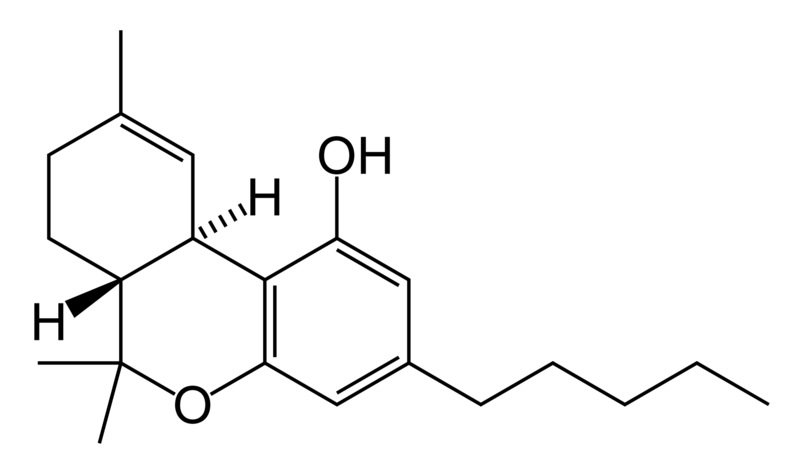420izzle
Well-Known Member
The big-pharma/medical industrial complex certainly hasn't tried to cure cancer, and I'd argue that it has in fact exasperated the problem. About 600,000 people die annually from cancer. It's time to STOP!
Below is a list of the naturally occurring components with cancer fighting properties from our favorite herb...
Anandamide

Source: Cannabis
http://www.ncbi.nlm.nih.gov/pmc/articles/PMC20983/
The endogenous cannabinoid anandamide inhibits human breast cancer cell proliferation
http://www.ncbi.nlm.nih.gov/pmc/articles/PMC20983/
Anandamide was the first brain metabolite shown to act as a ligand of "central" CB1 cannabinoid receptors. Here we report that the endogenous cannabinoid potently and selectively inhibits the proliferation of human breast cancer cells in vitro. Anandamide dose-dependently inhibited the proliferation of MCF-7 and EFM-19 cells with IC50 values between 0.5 and 1.5 ?M and 8392% maximal inhibition at 510 ?M. The proliferation of several other nonmammary tumoral cell lines was not affected by 10 ?M anandamide. The anti-proliferative effect of anandamide was not due to toxicity or to apoptosis of cells but was accompanied by a reduction of cells in the S phase of the cell cycle. ...These data suggest that anandamide blocks human breast cancer cell proliferation through CB1-like receptor-mediated inhibition of endogenous prolactin action at the level of prolactin receptor.
Anti-proliferative and apoptotic effects of anandamide in human prostatic cancer cell lines
http://onlinelibrary.wiley.com/doi/10.1002/pros.10190/abstract
ANA induced a decrease of EGFR levels on LNCaP, DU145, and PC3 prostatic cancer cells by acting through cannabinoid CB1 receptor subtype and this leaded to an inhibition of the EGF-stimulated growth of these cells. Moreover, the G1 arrest of metastatic DU145 and PC3 growth was accompanied by a massive cell death by apoptosis and/or necrosis while LNCaP cells were less sensitive to cytotoxic effects of ANA. The apoptotic/necrotic responses induced by ANA on these prostatic cancer cells were also potentiated by the acidic ceramidase inhibitor, N-oleoylethanolamine and partially inhibited by the specific ceramide synthetase inhibitor, fumonisin B1 indicating that these cytotoxic actions of ANA might be induced via the cellular ceramide production. The potent anti-proliferative and cytotoxic effects of ANA on metastatic prostatic cancer cells might provide basis for the design of new therapeutic agents for effective treatment of recurrent and invasive prostatic cancers.
Anandamide is an endogenous inhibitor for the migration of tumor cells and T lymphocytes
http://www.springerlink.com/content/h0m4052cq01vdba8/
Cell migration is of paramount importance in physiological processes such as immune surveillance, but also in the pathological processes of tumor cell migration and metastasis development. The factors that regulate this tumor cell migration, most prominently neurotransmitters, have thus been the focus of intense investigation. While the majority of neurotransmitters have a stimulatory effect on cell migration, we herein report the inhibitory effect of the endogenous substance anandamide on both tumor cell and lymphocyte migration. ...Using the specific agonist docosatetraenoylethanolamide (DEA), we have observed that the norepinephrine-induced migration of colon carcinoma cells is inhibited by the CB1-R. The SDF-1induced migration of CD8+ T lymphocytes was, however, inhibited via the CB2-R, as shown by using the specific agonist JWH 133. Therefore, specific inhibition of tumor cell migration via CB1-R engagement might be a selective tool to prevent metastasis formation without depreciatory effects on the immune system of cancer patients.
The endogenous cannabinoid, anandamide, induces cell death in colorectal carcinoma cells
http://gut.bmj.com/content/54/12/1741.abstract
These findings suggest anandamide may be a useful chemopreventive/therapeutic agent for colorectal cancer as it targets cells that are high expressors of COX-2, and may also be used in the eradication of tumour cells that have become resistant to apoptosis.
Arachidonyl Ethanolamide

Source: Cannabis
Arachidonyl ethanolamide induces apoptosis of uterine cervix cancer cells via aberrantly expressed vanilloid receptor-1
http://www.ncbi.nlm.nih.gov/pubmed/15047233
The major finding was that AEA induced apoptosis of CxCa cell lines via aberrantly expressed vanilloid receptor-1, whereas AEA binding to the classical CB1 and CB2 cannabinoid receptors mediated a protective effect. Furthermore, unexpectedly, a strong expression of the three forms of AEA receptors was observed in ex vivo CxCa biopsies.
THC

Source: Cannabis
http://en.wikipedia.org/wiki/Cannabis
Ths is an interesting one. There are studies showing cancer inhibition, and induction in various types of cancer. Considering the controversial nature of THC, there's no telling if there's foul play involved in the studies claiming it causes cancer. If you're considering using this treatment be sure to know your cell line and do deeper research.
The cannabinoid delta(9)-tetrahydrocannabinol inhibits RAS-MAPK and PI3K-AKT survival signalling and induces BAD-mediated apoptosis in colorectal cancer cells
http://www.ncbi.nlm.nih.gov/pubmed/17583570
The inhibition of ERK and AKT activity by THC was accompanied by activation of the proapoptotic BCL-2 family member BAD. Reduction of BAD protein expression by RNA interference rescued colorectal cancer cells from THC-induced apoptosis. These data suggest an important role for CB1 receptors and BAD in the regulation of apoptosis in colorectal cancer cells. The use of THC, or selective targeting of the CB1 receptor, may represent a novel strategy for colorectal cancer therapy.
Tetrahydrocannabinol Inhibits Cell Cycle Progression in Human Breast Cancer Cells
http://cancerres.aacrjournals.org/content/66/13/6615.abstract
Here, we show that ?9-tetrahydrocannabinol (THC), through activation of CB2 cannabinoid receptors, reduces human breast cancer cell proliferation by blocking the progression of the cell cycle and by inducing apoptosis.
Delta9-tetrahydrocannabinol induces apoptosis in human prostate PC-3 cells
http://www.ncbi.nlm.nih.gov/pubmed/10570948
The effect of delta9-tetrahydrocannabinol (THC), the major psycho-active component of marijuana, in human prostate cancer cells PC-3 was investigated. THC caused apoptosis in a dose-dependent manner. Morphological and biochemical changes induced by THC in prostate PC-3 cells shared the characteristics of an apoptotic phenomenon. First, loss of plasma membrane asymmetry determined by fluorescent anexin V binding. Second, presence of apoptotic bodies and nuclear fragmentation observed by DNA staining with 4',6-diamino-2-phenylindole (DAPI). Third, presence of typical 'ladder-patterned' DNA fragmentation. Central cannabinoid receptor expression was observed in PC-3 cells by immunofluorescence studies. However, several results indicated that the apoptotic effect was cannabinoid receptor-independent, such as lack of an effect of the potent cannabinoid agonist WIN 55,212-2, inability of cannabinoid antagonist AM 251 to prevent cellular death caused by THC and absence of an effect of pertussis toxin pre-treatment.
?9-Tetrahydrocannabinol inhibits epithelial growth factor-induced lung cancer cell migration in vitro as well as its growth and metastasis in vivoTHC inhibits NSCLC metastasis and growth
http://www.nature.com/onc/journal/v27/n3/full/1210641a.html
?9-Tetrahydrocannabinol (THC) is the primary cannabinoid of marijuana and has been shown to either potentiate or inhibit tumor growth, depending on the type of cancer and its pathogenesis. Little is known about the activity of cannabinoids like THC on epidermal growth factor receptor-overexpressing lung cancers, which are often highly aggressive and resistant to chemotherapy. In this study, we characterized the effects of THC on the EGF-induced growth and metastasis of human non-small cell lung cancer using the cell lines A549 and SW-1573 as in vitro models. We found that these cells express the cannabinoid receptors CB1 and CB2, known targets for THC action, and that THC inhibited EGF-induced growth, chemotaxis and chemoinvasion.
Cannabinoids Induce Cancer Cell Proliferation via Tumor Necrosis Factor ?-Converting Enzyme
http://cancerres.aacrjournals.org/content/66/13/6615.abstract
?9-Tetrahydrocannabinol-Induced Apoptosis in the Thymus and Spleen as a Mechanism of Immunosuppression in Vitro and in Vivo
jpet.aspetjournals.org...
Delta-9-tetrahydrocannabinol enhances breast cancer growth and metastasis by suppression of the antitumor immune response
http://www.ncbi.nlm.nih.gov/pubmed/15749859
Win55,212-2

Source: Cannabis
http://en.wikipedia.org/wiki/Cannabis
Cannabinoid Receptor-Mediated Apoptosis Induced by R(+)-Methanandamide and Win55,212-2
http://molpharm.aspetjournals.org/content/70/5/1612.abstract
We have recently shown that cannabinoids induce growth inhibition and apoptosis in mantle cell lymphoma (MCL), a malignant B-cell lymphoma that expresses high levels of cannabinoid receptor types 1 and 2 (CB1 and CB2). In the current study, the role of each receptor and the signal transduction triggered by receptor ligation were investigated. Induction of apoptosis after treatment with the synthetic agonists R(+)-methanandamide [R(+)-MA] and Win55,212-2 (Win55; (R)-(+)-[2,3-dihydro-5-methyl-3-(4-morpholinylmethyl) pyrrolo-[1,2,3-d,e]-1,4-benzoxazin-6-yl]-1-naphthalenyl-methanone) was dependent on both cannabinoid receptors,
There are certainly more...please post them!

Below is a list of the naturally occurring components with cancer fighting properties from our favorite herb...
Anandamide

Source: Cannabis
http://www.ncbi.nlm.nih.gov/pmc/articles/PMC20983/
The endogenous cannabinoid anandamide inhibits human breast cancer cell proliferation
http://www.ncbi.nlm.nih.gov/pmc/articles/PMC20983/
Anandamide was the first brain metabolite shown to act as a ligand of "central" CB1 cannabinoid receptors. Here we report that the endogenous cannabinoid potently and selectively inhibits the proliferation of human breast cancer cells in vitro. Anandamide dose-dependently inhibited the proliferation of MCF-7 and EFM-19 cells with IC50 values between 0.5 and 1.5 ?M and 8392% maximal inhibition at 510 ?M. The proliferation of several other nonmammary tumoral cell lines was not affected by 10 ?M anandamide. The anti-proliferative effect of anandamide was not due to toxicity or to apoptosis of cells but was accompanied by a reduction of cells in the S phase of the cell cycle. ...These data suggest that anandamide blocks human breast cancer cell proliferation through CB1-like receptor-mediated inhibition of endogenous prolactin action at the level of prolactin receptor.
Anti-proliferative and apoptotic effects of anandamide in human prostatic cancer cell lines
http://onlinelibrary.wiley.com/doi/10.1002/pros.10190/abstract
ANA induced a decrease of EGFR levels on LNCaP, DU145, and PC3 prostatic cancer cells by acting through cannabinoid CB1 receptor subtype and this leaded to an inhibition of the EGF-stimulated growth of these cells. Moreover, the G1 arrest of metastatic DU145 and PC3 growth was accompanied by a massive cell death by apoptosis and/or necrosis while LNCaP cells were less sensitive to cytotoxic effects of ANA. The apoptotic/necrotic responses induced by ANA on these prostatic cancer cells were also potentiated by the acidic ceramidase inhibitor, N-oleoylethanolamine and partially inhibited by the specific ceramide synthetase inhibitor, fumonisin B1 indicating that these cytotoxic actions of ANA might be induced via the cellular ceramide production. The potent anti-proliferative and cytotoxic effects of ANA on metastatic prostatic cancer cells might provide basis for the design of new therapeutic agents for effective treatment of recurrent and invasive prostatic cancers.
Anandamide is an endogenous inhibitor for the migration of tumor cells and T lymphocytes
http://www.springerlink.com/content/h0m4052cq01vdba8/
Cell migration is of paramount importance in physiological processes such as immune surveillance, but also in the pathological processes of tumor cell migration and metastasis development. The factors that regulate this tumor cell migration, most prominently neurotransmitters, have thus been the focus of intense investigation. While the majority of neurotransmitters have a stimulatory effect on cell migration, we herein report the inhibitory effect of the endogenous substance anandamide on both tumor cell and lymphocyte migration. ...Using the specific agonist docosatetraenoylethanolamide (DEA), we have observed that the norepinephrine-induced migration of colon carcinoma cells is inhibited by the CB1-R. The SDF-1induced migration of CD8+ T lymphocytes was, however, inhibited via the CB2-R, as shown by using the specific agonist JWH 133. Therefore, specific inhibition of tumor cell migration via CB1-R engagement might be a selective tool to prevent metastasis formation without depreciatory effects on the immune system of cancer patients.
The endogenous cannabinoid, anandamide, induces cell death in colorectal carcinoma cells
http://gut.bmj.com/content/54/12/1741.abstract
These findings suggest anandamide may be a useful chemopreventive/therapeutic agent for colorectal cancer as it targets cells that are high expressors of COX-2, and may also be used in the eradication of tumour cells that have become resistant to apoptosis.
Arachidonyl Ethanolamide

Source: Cannabis
Arachidonyl ethanolamide induces apoptosis of uterine cervix cancer cells via aberrantly expressed vanilloid receptor-1
http://www.ncbi.nlm.nih.gov/pubmed/15047233
The major finding was that AEA induced apoptosis of CxCa cell lines via aberrantly expressed vanilloid receptor-1, whereas AEA binding to the classical CB1 and CB2 cannabinoid receptors mediated a protective effect. Furthermore, unexpectedly, a strong expression of the three forms of AEA receptors was observed in ex vivo CxCa biopsies.
THC

Source: Cannabis
http://en.wikipedia.org/wiki/Cannabis
Ths is an interesting one. There are studies showing cancer inhibition, and induction in various types of cancer. Considering the controversial nature of THC, there's no telling if there's foul play involved in the studies claiming it causes cancer. If you're considering using this treatment be sure to know your cell line and do deeper research.
The cannabinoid delta(9)-tetrahydrocannabinol inhibits RAS-MAPK and PI3K-AKT survival signalling and induces BAD-mediated apoptosis in colorectal cancer cells
http://www.ncbi.nlm.nih.gov/pubmed/17583570
The inhibition of ERK and AKT activity by THC was accompanied by activation of the proapoptotic BCL-2 family member BAD. Reduction of BAD protein expression by RNA interference rescued colorectal cancer cells from THC-induced apoptosis. These data suggest an important role for CB1 receptors and BAD in the regulation of apoptosis in colorectal cancer cells. The use of THC, or selective targeting of the CB1 receptor, may represent a novel strategy for colorectal cancer therapy.
Tetrahydrocannabinol Inhibits Cell Cycle Progression in Human Breast Cancer Cells
http://cancerres.aacrjournals.org/content/66/13/6615.abstract
Here, we show that ?9-tetrahydrocannabinol (THC), through activation of CB2 cannabinoid receptors, reduces human breast cancer cell proliferation by blocking the progression of the cell cycle and by inducing apoptosis.
Delta9-tetrahydrocannabinol induces apoptosis in human prostate PC-3 cells
http://www.ncbi.nlm.nih.gov/pubmed/10570948
The effect of delta9-tetrahydrocannabinol (THC), the major psycho-active component of marijuana, in human prostate cancer cells PC-3 was investigated. THC caused apoptosis in a dose-dependent manner. Morphological and biochemical changes induced by THC in prostate PC-3 cells shared the characteristics of an apoptotic phenomenon. First, loss of plasma membrane asymmetry determined by fluorescent anexin V binding. Second, presence of apoptotic bodies and nuclear fragmentation observed by DNA staining with 4',6-diamino-2-phenylindole (DAPI). Third, presence of typical 'ladder-patterned' DNA fragmentation. Central cannabinoid receptor expression was observed in PC-3 cells by immunofluorescence studies. However, several results indicated that the apoptotic effect was cannabinoid receptor-independent, such as lack of an effect of the potent cannabinoid agonist WIN 55,212-2, inability of cannabinoid antagonist AM 251 to prevent cellular death caused by THC and absence of an effect of pertussis toxin pre-treatment.
?9-Tetrahydrocannabinol inhibits epithelial growth factor-induced lung cancer cell migration in vitro as well as its growth and metastasis in vivoTHC inhibits NSCLC metastasis and growth
http://www.nature.com/onc/journal/v27/n3/full/1210641a.html
?9-Tetrahydrocannabinol (THC) is the primary cannabinoid of marijuana and has been shown to either potentiate or inhibit tumor growth, depending on the type of cancer and its pathogenesis. Little is known about the activity of cannabinoids like THC on epidermal growth factor receptor-overexpressing lung cancers, which are often highly aggressive and resistant to chemotherapy. In this study, we characterized the effects of THC on the EGF-induced growth and metastasis of human non-small cell lung cancer using the cell lines A549 and SW-1573 as in vitro models. We found that these cells express the cannabinoid receptors CB1 and CB2, known targets for THC action, and that THC inhibited EGF-induced growth, chemotaxis and chemoinvasion.
Cannabinoids Induce Cancer Cell Proliferation via Tumor Necrosis Factor ?-Converting Enzyme
http://cancerres.aacrjournals.org/content/66/13/6615.abstract
?9-Tetrahydrocannabinol-Induced Apoptosis in the Thymus and Spleen as a Mechanism of Immunosuppression in Vitro and in Vivo
jpet.aspetjournals.org...
Delta-9-tetrahydrocannabinol enhances breast cancer growth and metastasis by suppression of the antitumor immune response
http://www.ncbi.nlm.nih.gov/pubmed/15749859
Win55,212-2

Source: Cannabis
http://en.wikipedia.org/wiki/Cannabis
Cannabinoid Receptor-Mediated Apoptosis Induced by R(+)-Methanandamide and Win55,212-2
http://molpharm.aspetjournals.org/content/70/5/1612.abstract
We have recently shown that cannabinoids induce growth inhibition and apoptosis in mantle cell lymphoma (MCL), a malignant B-cell lymphoma that expresses high levels of cannabinoid receptor types 1 and 2 (CB1 and CB2). In the current study, the role of each receptor and the signal transduction triggered by receptor ligation were investigated. Induction of apoptosis after treatment with the synthetic agonists R(+)-methanandamide [R(+)-MA] and Win55,212-2 (Win55; (R)-(+)-[2,3-dihydro-5-methyl-3-(4-morpholinylmethyl) pyrrolo-[1,2,3-d,e]-1,4-benzoxazin-6-yl]-1-naphthalenyl-methanone) was dependent on both cannabinoid receptors,
There are certainly more...please post them!

